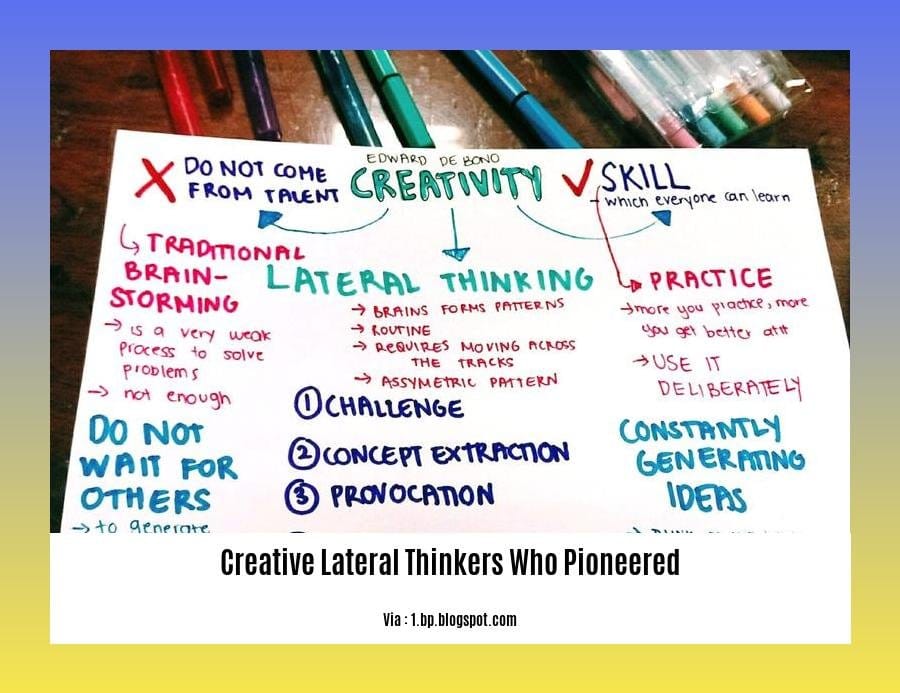Uncover the fascinating stories of extraordinary creative lateral thinkers in [Creative Lateral Thinkers Who Pioneered Disruptive Innovations]. Explore how these visionaries challenged norms, unlocked potential, and transformed industries with their disruptive ideas and unconventional approaches.
Key Takeaways:

- Lateral thinking, a creative problem-solving approach, involves using unconventional ideas and breaking away from traditional logic.
- It encourages an unconventional mindset and techniques like using analogy, embracing randomness, and challenging assumptions.
- Steve Jobs and Elon Musk are examples of successful innovators who have used lateral thinking to foster creativity.
Creative Lateral Thinkers Who Pioneered Disruptive Innovations
The path to innovation is paved with unconventional ideas, and creative lateral thinkers who pioneered disruptive technologies paved the way for a better world.
Unlocking Hidden Potential with Lateral Thinking
Lateral thinking, a problem-solving approach that encourages unconventional reasoning, empowers individuals to break free from traditional logic. By embracing randomness, using analogies, and challenging assumptions, lateral thinkers unleash their creativity and ignite innovation.
Techniques to Think Differently
1. Embrace Randomness: Expose yourself to different ideas, experiences, and perspectives. Let your mind wander and connect seemingly unrelated concepts.
2. Use Analogy: Compare different situations or problems. By uncovering similarities, you may find unexpected solutions.
3. Challenge Assumptions: Question the status quo and explore alternative possibilities. Don’t take anything for granted.
Breaking Barriers with Disruptive Innovations
Steve Jobs: The visionary behind Apple, Jobs utilized lateral thinking to revolutionize the tech industry. From the user-friendly interface of the iPhone to the sleek design of the iMac, his products exemplified the power of creative problem-solving.
Elon Musk: The founder of Tesla and SpaceX, Musk continuously challenges conventions. His innovative ideas, such as electric vehicles and reusable rockets, have pushed the boundaries of technology and sustainability.
Embracing the Power of Curiosity
At the heart of every creative lateral thinker lies an insatiable curiosity. They question, explore, and experiment, driven by a desire to make a meaningful impact on the world. Their unconventional approaches and willingness to challenge the norm have led to transformative innovations that have shaped our lives.
- Pioneers known for their creative problem-solving have always been a source of inspiration for budding entrepreneurs.
- Innovators hailed for novel solutions have shaped the fabric of our lives in innumerable ways.
- Pioneers celebrated for their unconventional approaches are the epitome of brilliance and audacity.
Lateral Thinking in Business
In the realm of business, lateral thinking stands as a transformative force, empowering leaders to break free from conventional wisdom and unlock disruptive innovations. This problem-solving approach challenges traditional patterns of thought, fostering adaptability and the generation of creative solutions.
Key Takeaways:
- Lateral Thinking: A non-traditional problem-solving approach that seeks innovative solutions beyond conventional logic.
- Benefits: Enhanced creativity, improved problem-solving abilities, and increased adaptability.
- Techniques:
- Provocation: Questioning assumptions and seeking alternative perspectives.
- Random Input: Using external stimuli like images or words to spark ideas.
- Reversal: Exploring the opposite or reverse of a problem to uncover novel solutions.
- Examples: Steve Jobs and Elon Musk pushed technological and sustainability boundaries through lateral thinking.
Benefits of Lateral Thinking in Business:
- Innovation: Generates unique and groundbreaking ideas that drive business growth.
- Problem-Solving: Overcomes challenges and finds unconventional solutions to complex business issues.
- Adaptability: Prepares businesses to navigate changing market dynamics and embrace new opportunities.
How to Apply Lateral Thinking in Business:
- Encourage Brainstorming: Foster a collaborative environment where open and unconventional ideas are welcome.
- Challenge Assumptions: Question established norms and seek out alternative perspectives from diverse stakeholders.
- Use Visual Aids: Incorporate mind maps, diagrams, or sketches to visualize ideas and connections.
- Embrace Randomness: Introduce external elements into brainstorming sessions to stimulate creativity and spark new insights.
- Test and Iterate: Experiment with different solutions, gather feedback, and refine ideas to maximize impact.
By embracing lateral thinking in business, organizations can unlock their creative potential, drive innovation, and stay ahead in the competitive landscape.
Source:
Lateral thinking in society
Lateral thinking is a problem-solving approach that seeks innovative solutions by breaking away from conventional thought patterns. This approach is crucial in today’s society, where we face complex challenges that require unconventional thinking.
Immigrants, with their outsider perspectives, often possess strong lateral thinking skills. They have had to adapt to new cultures and environments, developing the ability to think differently and find creative solutions. This has led to significant contributions from immigrant entrepreneurs like Levi Strauss, Elon Musk, and Sergey Brin, who have founded many fast-growing startups.
Lateral Thinking has also revolutionized various industries. For instance, Don Estridge’s open architecture for the IBM PC allowed for the creation of a wide range of compatible products, transforming the personal computer market. Muhammad Yunus’s microfinance model has empowered millions of poor people, providing them with access to financial services and helping them to lift themselves out of poverty. Queen’s “Bohemian Rhapsody” defied musical conventions, becoming a timeless masterpiece that continues to inspire and entertain.
Key Takeaways:
- Lateral thinking challenges conventional wisdom and seeks innovative solutions.
- Immigrants often possess strong lateral thinking skills due to their outsider perspectives.
- Lateral thinking has led to groundbreaking innovations in technology, business, and the arts.
Source:
- De Bono, E. (1967). New think: The use of lateral thinking in the generation of new ideas. The de Bono Group.
Impact of Lateral Thinking on Modern Innovation
Lateral thinking empowers individuals and organizations to break free from conventional norms and unlock hidden potential, driving transformative innovations that shape our modern landscape.
Key Takeaways:
- Lateral thinking enables innovative solutions by exploring unconventional approaches.
- It enhances creativity, problem-solving abilities, and adaptability.
- Organizations that embrace lateral thinking gain a competitive edge in a rapidly changing environment.
- Examples include advancements in technology, sustainability, and business practices.
- Lateral thinkers challenge assumptions, explore different perspectives, and experiment with new ideas.
Citation:
– The Importance of Lateral Thinking Skills

FAQ
Q1: Who are some notable creative lateral thinkers who pioneered disruptive innovations?
A1: Creative lateral thinkers who have pioneered disruptive innovations include Edward de Bono, Steve Jobs, and Elon Musk, among others.
Q2: What are some techniques employed by creative lateral thinkers?
A2: Creative lateral thinkers employ various techniques to challenge norms and unlock hidden potential, including embracing randomness, using analogy, and challenging assumptions.
Q3: How can lateral thinking contribute to transformative change?
A3: Lateral thinking fosters adaptability and innovation, enabling individuals and organizations to break away from traditional patterns and create unconventional solutions that drive transformative change.
Q4: What are the benefits of incorporating lateral thinking into problem-solving processes?
A4: Lateral thinking offers a range of benefits, including enhanced creativity, improved problem-solving abilities, and greater adaptability, leading to more innovative outcomes.
Q5: How can one develop stronger lateral thinking skills?
A5: To develop stronger lateral thinking skills, one can practice techniques such as provocation, random input, and challenging assumptions, as well as engaging in activities that encourage unconventional perspectives and creative thinking.
















